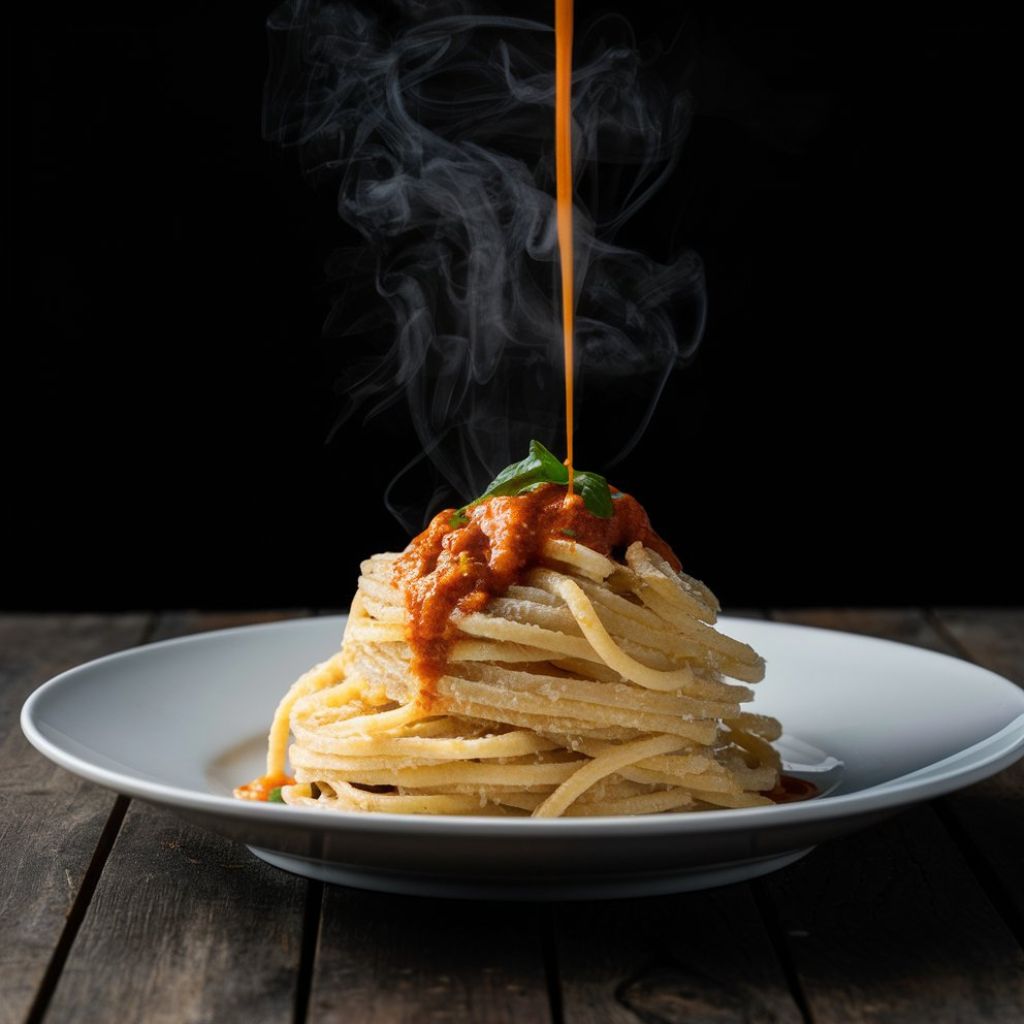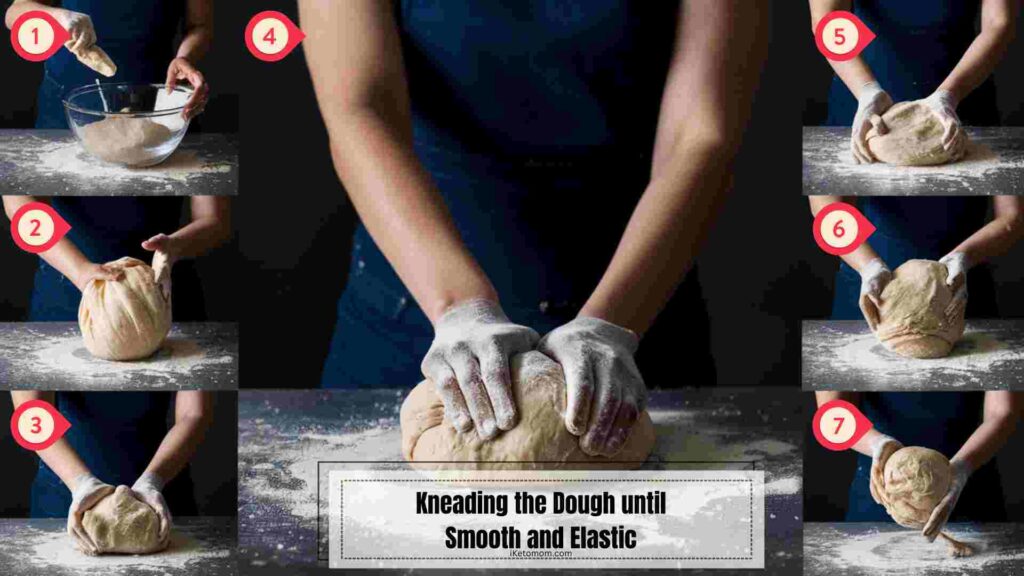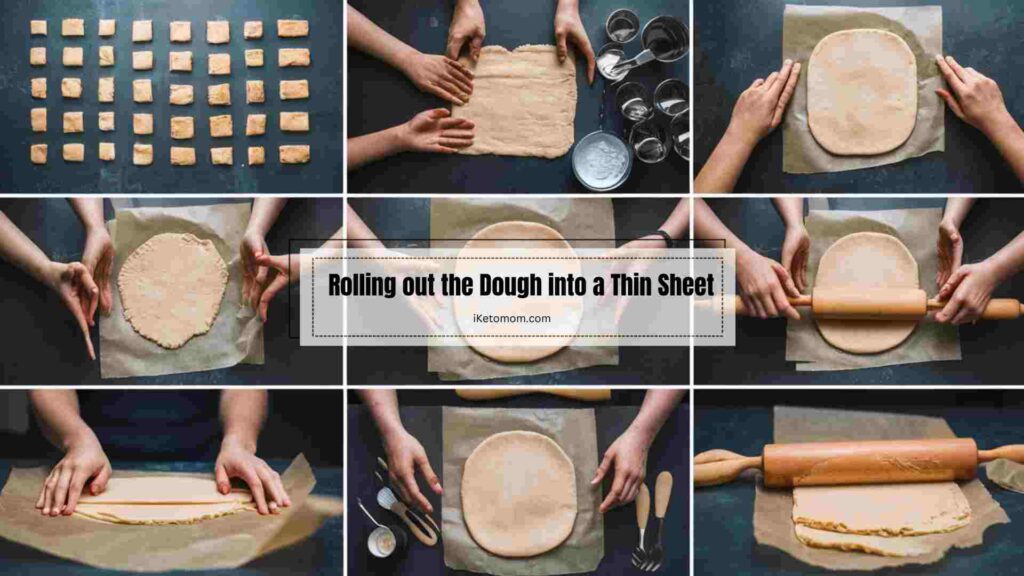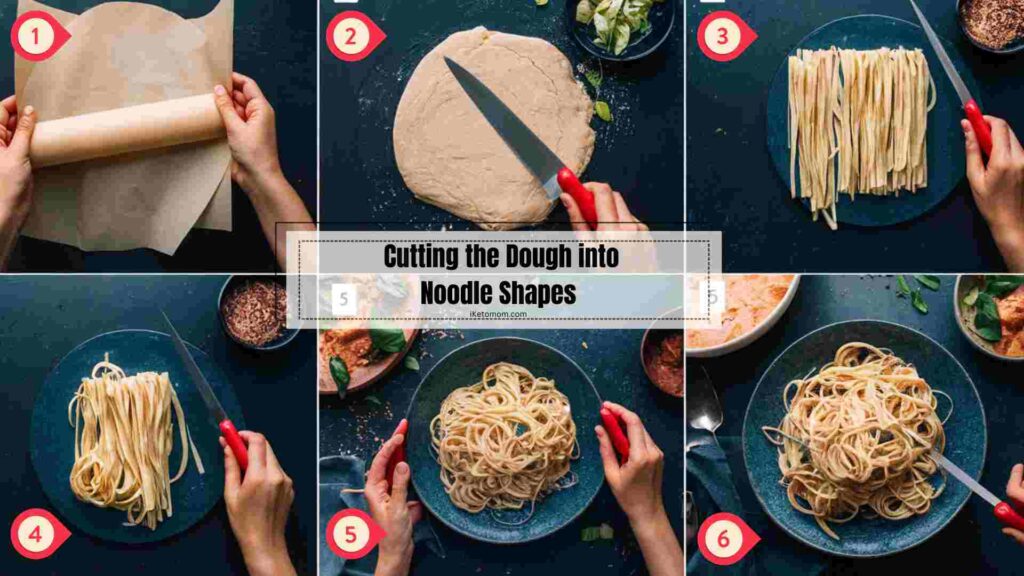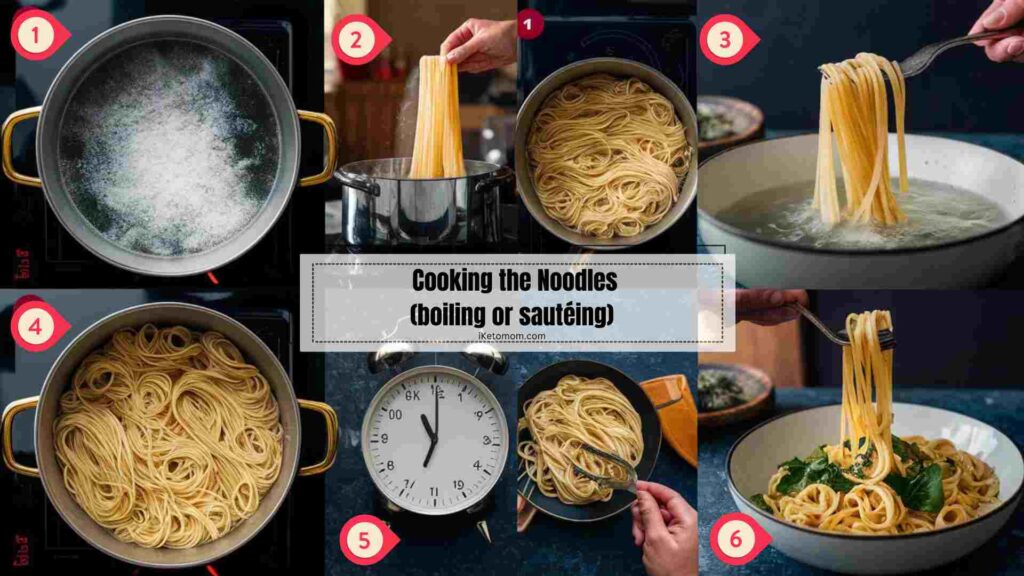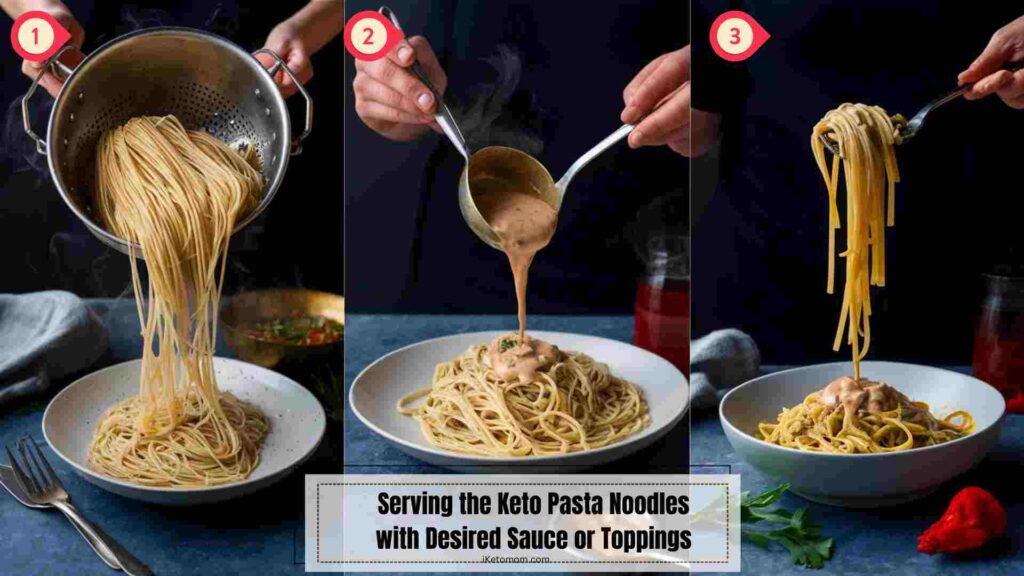Introducing Keto Pasta Noodles as a low-carb alternative opens up a world of possibilities for those following the Keto lifestyle. Traditional pasta is high in carbohydrates, which can spike blood sugar levels and hinder ketosis. Keto Pasta Noodles, on the other hand, are made with almond flour and psyllium husk, keeping the carb count low while providing a satisfying pasta experience. This alternative allows individuals on Keto to enjoy their favorite pasta dishes without compromising their dietary goals.
Keto Pasta Noodles promise a delicious pasta experience without the carbs, offering a guilt-free indulgence for pasta lovers on the Keto diet. By using wholesome ingredients and smart substitutions, such as almond flour instead of wheat flour, these noodles mimic the texture and taste of traditional pasta while supporting a low-carb lifestyle. Whether paired with a rich marinara sauce, creamy Alfredo, or tossed in a flavorful pesto, Keto Pasta Noodles deliver on taste and satisfaction without the carb-heavy consequences.
Keto Pasta Noodles Recipe
Ingredients
1. 1 cup almond flour:
Almond flour is a finely ground flour made from blanched almonds. It’s commonly used in Keto and gluten-free recipes as a substitute for wheat flour. Almond flour adds a nutty flavor and helps bind the ingredients together in the Keto Pasta Noodles dough.
2. 2 tablespoons psyllium husk powder:
Psyllium husk powder is a soluble fiber derived from the seeds of the Plantago ovata plant. It’s often used in Keto baking to provide structure and elasticity to doughs. Psyllium husk powder helps give the Keto Pasta Noodles a pasta-like texture without the need for high-carb flours.
3. 1/4 teaspoon salt:
Salt is added to the dough to enhance the flavor of the Keto Pasta Noodles. It also helps balance the sweetness of almond flour and adds depth to the overall taste of the dish.
4. 2 large eggs:
Eggs act as a binding agent in the Keto Pasta Noodles dough. They help hold the ingredients together and contribute to the texture of the noodles. The fat and protein in eggs also add richness and nutritional value to the dish.
5. 1 tablespoon olive oil or melted butter:
Olive oil or melted butter adds moisture and richness to the Keto Pasta Noodles dough. It helps prevent the noodles from becoming too dry and adds a subtle flavor that complements various sauces and toppings.
6. Additional seasonings or herbs (optional):
You can customize the flavor of your Keto Pasta Noodles by adding optional seasonings or herbs. Common choices include garlic powder, Italian seasoning, parsley, basil, or red pepper flakes. These additions can enhance the taste of the noodles and complement the sauces you choose to pair them with.
By combining these ingredients, you’ll create a flavorful and low-carb alternative to traditional pasta that’s perfect for a Keto-friendly meal. Adjust the optional seasonings to suit your taste preferences and enjoy a delicious pasta experience without the carbs.
Instructions
1. Mixing the Dry Ingredients (almond flour, psyllium husk powder, salt):
- In a large mixing bowl, combine 1 cup of almond flour, 2 tablespoons of psyllium husk powder, and 1/4 teaspoon of salt.
- Use a whisk or fork to thoroughly mix the dry ingredients until well combined. Ensure there are no lumps in the mixture.
2. Incorporating the Wet Ingredients (eggs, olive oil/melted butter):
- Create a well in the center of the dry ingredients mixture.
- Crack 2 large eggs into the well and add 1 tablespoon of olive oil or melted butter.
- Use a spatula or your hands to gradually incorporate the wet ingredients into the dry mixture. Mix until a cohesive dough forms.
3. Kneading the Dough until Smooth and Elastic:
- Transfer the dough onto a clean, almond-floured surface.
- Begin kneading the dough by folding it over onto itself and pressing down with the heel of your hand.
- Continue kneading for about 3-5 minutes until the dough becomes smooth, elastic, and uniform in texture. Add a sprinkle of almond flour as needed to prevent sticking.
4. Rolling out the Dough into a Thin Sheet:
- Divide the dough into smaller portions for easier handling.
- Flatten one portion of dough into a rough rectangle shape with your hands.
- Place the dough between two sheets of parchment paper to prevent sticking.
- Use a rolling pin to roll out the dough into a thin, even sheet. Aim for a thickness similar to traditional pasta.
5. Cutting the Dough into Noodle Shapes:
- Remove the top sheet of parchment paper from the rolled-out dough.
- Use a sharp knife or a pasta cutter to cut the dough into noodle shapes of your desired width. You can make fettuccine, linguine, or any other shape you prefer.
6. Cooking the Noodles (boiling or sautéing):
- To boil: Bring a pot of salted water to a boil. Add the Keto Pasta noodles and cook for 2-4 minutes or until al dente. Avoid overcooking to maintain the texture.
- To sauté: Heat a pan over medium heat and add a small amount of olive oil or butter. Add the Keto Pasta noodles and sauté for 2-3 minutes until heated through and slightly golden.
7. Serving the Keto Pasta Noodles with Desired Sauce or Toppings:
- Once cooked, drain the boiled noodles if necessary or remove the sautéed noodles from the pan.
- Serve the Keto Pasta Noodles hot with your favorite Keto-friendly sauce, such as marinara made with low-carb ingredients, creamy Alfredo, or a pesto sauce. Add grated cheese, fresh herbs, or other toppings as desired.
- Enjoy your homemade Keto Pasta Noodles as a delicious and satisfying low-carb meal! Adjust seasoning and sauce according to your taste preferences.
These instructions guide you through the process of creating delicious Keto Pasta’s Noodles from scratch. By carefully mixing the dry ingredients like almond flour, psyllium husk powder, and salt, you create a base that’s then enriched with eggs and olive oil or melted butter. The kneading process is crucial, ensuring the dough becomes smooth and elastic for optimal texture. Rolling out the dough thinly and cutting it into noodle shapes gives you the traditional pasta experience. Whether you choose to boil or sauté the noodles, they cook quickly and can be served with your favorite Keto-friendly sauce or toppings, offering a satisfying and carb-conscious pasta’s option.
Keto Pasta is a low-carbohydrate alternative to traditional pasta, specifically designed for those following a ketogenic diet. It replaces high-carb ingredients like wheat flour with low-carb alternatives such as almond flour or coconut flour, along with other keto-friendly ingredients like eggs and psyllium husk powder. The purpose of Keto Pasta is to provide a satisfying pasta experience without the carb-heavy consequences that can disrupt ketosis.
One of the key benefits of Keto Pasta is its ability to fit into a ketogenic lifestyle while still offering the familiar taste and texture of pasta. It allows individuals on a keto diet to enjoy their favorite pasta dishes without sacrificing their dietary goals. Keto Pasta can be used in a variety of recipes, from classic spaghetti and meatballs to creamy Alfredo or pesto pasta dishes.
Keto Pasta Nutrition Info
Here’s a nutrition table for a basic Keto Pasta Noodles recipe (per serving):
| Nutrient | Amount Per Serving |
|---|---|
| Calories | 280 kcal |
| Total Fat | 22g |
| – Saturated Fat | 4g |
| Cholesterol | 110mg |
| Sodium | 180mg |
| Total Carbohydrates | 9g |
| – Dietary Fiber | 5g |
| – Sugars | 1g |
| Protein | 12g |
Note: Nutritional values are approximate and can vary based on specific ingredients and serving sizes.
Here’s a combined nutrition table for each ingredient used in the Keto Pasta Noodles recipe:
| Ingredient | Serving Size | Calories | Total Fat | Saturated Fat | Cholesterol | Sodium | Total Carbohydrates | Dietary Fiber | Sugars | Protein |
|---|---|---|---|---|---|---|---|---|---|---|
| Almond Flour | 1 cup (96g) | 640 kcal | 56g | 4g | 0mg | 0mg | 24g | 12g | 4g | 24g |
| Psyllium Husk Powder | 2 tbsp (16g) | 60 kcal | 0g | 0g | 0mg | 0mg | 16g | 14g | 0g | 0g |
| Eggs (2 large) | 100g with shell | 140 kcal | 10g | 3g | 372mg | 140mg | 1g | 0g | 1g | 12g |
| Olive Oil | 1 tbsp (14g) | 120 kcal | 14g | 2g | 0mg | 0mg | 0g | 0g | 0g | 0g |
Note: Nutritional values are approximate and can vary based on specific brands and measurements.
Tips for Best Results 🍽
Here are some tips to ensure the best results when making Keto Pasta Noodles:
- Use High-Quality Ingredients: Opt for high-quality almond flour, psyllium husk powder, eggs, and olive oil or butter. Fresh and good-quality ingredients will contribute to better taste and texture.
- Measure Ingredients Accurately: Use measuring cups and spoons to accurately measure ingredients, especially almond flour and psyllium husk powder. Precision in measurements helps maintain the right consistency of the dough.
- Let the Dough Rest: After mixing the ingredients, allow the dough to rest for a few minutes. This allows the psyllium husk powder to absorb moisture, making the dough easier to work with and improving its texture.
- Knead the Dough Thoroughly: Take the time to knead the dough until it becomes smooth and elastic. Proper kneading helps develop the gluten-like structure in the dough, ensuring the noodles hold their shape and have a pleasant texture after cooking.
- Roll the Dough Thinly: Roll out the dough into a thin sheet for optimal results. Thinner noodles cook more evenly and have a more traditional pasta-like texture.
- Avoid Overcooking: Whether boiling or sautéing the noodles, avoid overcooking them. Keto Pasta noodles cook faster than traditional pasta, so keep a close eye and cook just until al dente to maintain their texture and prevent them from becoming mushy.
- Experiment with Seasonings: Add optional seasonings or herbs to the dough for added flavor. Garlic powder, Italian seasoning, or dried herbs like basil and oregano can enhance the taste of the noodles.
- Pair with Keto-Friendly Sauces: Choose Keto-friendly sauces such as marinara made with low-carb ingredients, creamy Alfredo sauce, or a pesto sauce to complement the Keto Pasta Noodles. These sauces add flavor without adding unnecessary carbs.
- Store and Reheat Properly: If storing leftover cooked noodles, store them in an airtight container in the refrigerator. Reheat gently to prevent them from becoming too soft.
- Enjoy Fresh: Keto Pasta Noodles are best enjoyed fresh, so try to serve and enjoy them shortly after cooking for the best taste and texture.
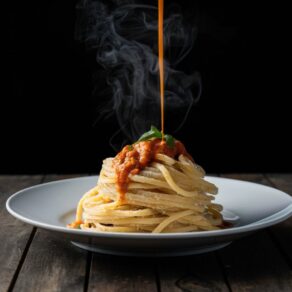
Keto Pasta Noodles Recipe
Equipment
- Mixing bowl For combining the dry ingredients and wet ingredients to form the dough.
- Measuring cups and spoons To measure the precise amounts of flour, psyllium husk, eggs, oil, and seasoning.
- Whisk or Fork For mixing the wet and dry ingredients together until well combined.
- Rolling Pin To roll out the dough into a thin sheet for cutting into noodles.
- Knife or Pasta Cutter For cutting the rolled-out dough into noodle shapes. A sharp knife or a pasta cutter can work well for this step.
- Pot or Pan with Lid If boiling the pasta, you'll need a pot with enough water to cook the noodles. If sautéing, a pan with a lid for steaming the pasta.
- Strainer or Slotted Spoon For draining the boiled pasta if using the boiling method.
- Serving Dish To present and serve the cooked Keto Pasta noodles.
- Optional: Pasta Drying Rack: If you prefer to dry the pasta before cooking, a pasta drying rack can be useful.
Ingredients
- 1 Cup Almond Flour
- 2 Tablespoons Psyllium Husk Powder
- 1/4 Teaspoon Salt
- 2 Large eggs
- 1 Tablespoon Olive Oil or Melted Butter
- Additional seasonings or herbs (optional, to taste)
Instructions
- Mixing the dry ingredients (almond flour, psyllium husk powder, salt)
- Incorporating the wet ingredients (eggs, olive oil/melted butter)
- Kneading the dough until smooth and elastic
- Rolling out the dough into a thin sheet
- Cutting the dough into noodle shapes
- Cooking the noodles (boiling or sautéing)
- Serving the Keto Pasta Noodles with desired sauce or toppings
Notes
Delicious Topping Ideas
Here are some delicious topping ideas to elevate your Keto Pasta Noodles:
1. Creamy Alfredo Sauce:
Whip up a rich and creamy Alfredo sauce using heavy cream, butter, garlic, and Parmesan cheese. Toss your cooked Keto Pasta Noodles in this luxurious sauce for a decadent meal.
2. Pesto Sauce:
Blend fresh basil, garlic, pine nuts, Parmesan cheese, and olive oil to create a vibrant and flavorful pesto sauce. Coat your noodles with this green goodness for a burst of herbal goodness.
3. Marinara Sauce:
Make a Keto-friendly marinara sauce using tomatoes, onions, garlic, herbs like basil and oregano, and a touch of low-carb sweetener. Simmer the sauce until thick and robust, then mix it with your pasta noodles for a classic Italian dish.
4. Creamy Garlic Parmesan Sauce:
Combine heavy cream, garlic, Parmesan cheese, and butter in a saucepan for a velvety and indulgent sauce. Drizzle it over your Keto Pasta Noodles for a comforting and satisfying meal.
5. Carbonara Sauce:
Create a creamy Carbonara sauce using eggs, bacon or pancetta, Parmesan cheese, and black pepper. Toss your noodles with this savory sauce for a hearty and flavorful dish.
6. Mushroom and Spinach Saute:
Sauté sliced mushrooms and baby spinach in butter or olive oil until tender. Season with salt, pepper, and garlic for a delicious and nutritious topping for your pasta.
7. Grilled Chicken:
Grill or sauté chicken breast seasoned with Italian herbs and garlic. Slice the chicken and serve it on top of your Keto Pasta Noodles for a protein-packed meal.
8. Shrimp Scampi:
Cook shrimp in a garlic and butter sauce with a splash of white wine or lemon juice. Serve the shrimp and sauce over your noodles for a light and refreshing seafood dish.
9. Roasted Vegetables:
Roast a medley of low-carb vegetables like bell peppers, zucchini, and cherry tomatoes with olive oil, salt, and pepper. Toss them with your pasta noodles for a colorful and flavorful topping.
10. Fresh Herbs and Parmesan:
Finish off your Keto Pasta Noodles with a sprinkle of fresh chopped herbs like parsley or basil and a generous grating of Parmesan cheese for added freshness and umami flavor.
FAQ
What are Keto Pasta Noodles?
Keto pasta noodles are a low-carbohydrate alternative to traditional pasta, designed to fit within the guidelines of a ketogenic diet. The ketogenic diet is a high-fat, low-carbohydrate diet that aims to induce ketosis, a metabolic state where the body burns fat for fuel instead of carbohydrates. Traditional pasta is high in carbohydrates, which makes it unsuitable for a keto diet. Keto pasta noodles are made using ingredients that are low in carbs and high in fiber or protein. Here are some common types of keto pasta noodles:
- Zucchini Noodles (Zoodles): Made from spiralized zucchini, these noodles are low in carbs and can be eaten raw or cooked.
- Shirataki Noodles: Also known as miracle noodles, these are made from the konjac yam and are very low in calories and carbs, primarily composed of water and glucomannan fiber.
- Spaghetti Squash: When cooked, the flesh of this squash can be shredded into spaghetti-like strands, offering a low-carb alternative to pasta.
- Almond Flour or Coconut Flour Noodles: These are made using low-carb flours such as almond or coconut flour mixed with eggs and other ingredients to form a dough, which is then shaped into noodles.
- Palmini Noodles: Made from hearts of palm, these noodles are low in carbs and have a texture similar to that of traditional pasta.
- Cabbage or Lettuce Noodles: Thinly sliced cabbage or lettuce can be used as a low-carb noodle substitute in various dishes.
- Cheese Noodles: Made by melting cheese and forming it into thin strips or shapes, these noodles are both low in carbs and high in fat, making them ideal for a keto diet.
These alternatives provide a way to enjoy pasta dishes without the high carb content of traditional pasta, allowing those on a keto diet to maintain their dietary goals while still enjoying a variety of meals.
Are Keto Pasta Noodles gluten-free?
Yes, most keto pasta noodles are gluten-free because they are made from ingredients that do not contain gluten. Here are some details about the gluten-free nature of various keto pasta noodles:
- Zucchini Noodles (Zoodles): Made from spiralized zucchini, which is naturally gluten-free.
- Shirataki Noodles: Made from the konjac yam, which is gluten-free.
- Spaghetti Squash: The flesh of the squash is naturally gluten-free.
- Almond Flour or Coconut Flour Noodles: Both almond flour and coconut flour are gluten-free. However, it is important to ensure that there is no cross-contamination during processing.
- Palmini Noodles: Made from hearts of palm, which are naturally gluten-free.
- Cabbage or Lettuce Noodles: Both cabbage and lettuce are naturally gluten-free.
- Cheese Noodles: Made from cheese, which is naturally gluten-free.
When purchasing pre-made keto noodles or noodle substitutes, it’s always important to check the packaging for any gluten-containing additives or potential cross-contamination, especially if you have celiac disease or a gluten sensitivity. Many brands specifically label their products as gluten-free to provide assurance to consumers with dietary restrictions.
Can I use different flours for Keto Pasta Noodles?
Yes, you can experiment with different low-carbohydrate flours to make Keto Pasta Noodles. While almond flour and coconut flour are commonly used in Keto recipes, there are other options you can explore to suit your taste preferences and dietary needs. Here are some alternative flours you can consider for making Keto Pasta Noodles:
- Almond Flour: Almond flour is a popular choice for Keto Pasta Noodles due to its mild flavor and low carbohydrate content. It provides a slightly nutty taste and a tender texture to the noodles.
- Coconut Flour: Coconut flour is another low-carb option that adds a subtle coconut flavor to the noodles. It absorbs more liquid than almond flour, so you may need to adjust the amount of liquid in the recipe accordingly.
- Flaxseed Meal: Ground flaxseeds, also known as flaxseed meal, can be used to make Keto Pasta Noodles. Flaxseed meal adds a nutty flavor and is high in fiber, which can be beneficial for digestion.
- Psyllium Husk Powder: Psyllium husk powder is a soluble fiber that can be used to bind the ingredients in Keto Pasta Noodles. It helps create a dough-like consistency and adds fiber to the noodles.
- Chia Seed Flour: Ground chia seeds can be used as a flour substitute in Keto Pasta Noodles. Chia seeds are high in fiber and omega-3 fatty acids, providing nutritional benefits to the noodles.
- Soy Flour: Soy flour is low in carbohydrates and can be used to make Keto Pasta Noodles. It has a mild taste and adds protein to the noodles.
When using alternative flours for Keto Pasta Noodles, keep in mind that the texture and flavor may vary compared to traditional wheat-based pasta. It may require some experimentation to find the right combination of ingredients and ratios to achieve the desired taste and texture. Additionally, adjust the liquid content and cooking time as needed based on the flour you choose to ensure the noodles turn out well.

I’m Priscilla Swahn, a registered dietitian with a master’s degree in nutritional sciences. With over a decade of experience in holistic nutrition, I specialize in creating delicious keto recipes to help you enjoy a healthy lifestyle. On iKetoMom, you’ll find a variety of recipes for every meal—hearty breakfasts, satisfying lunches, mouthwatering dinners, indulgent desserts, and refreshing drinks. My recipes make keto living easy and enjoyable for the whole family. Featured in EatingWell and MindBodyGreen, I also collaborate with health centers and corporate companies to share my expertise. Join me and discover the joy of keto cooking!

